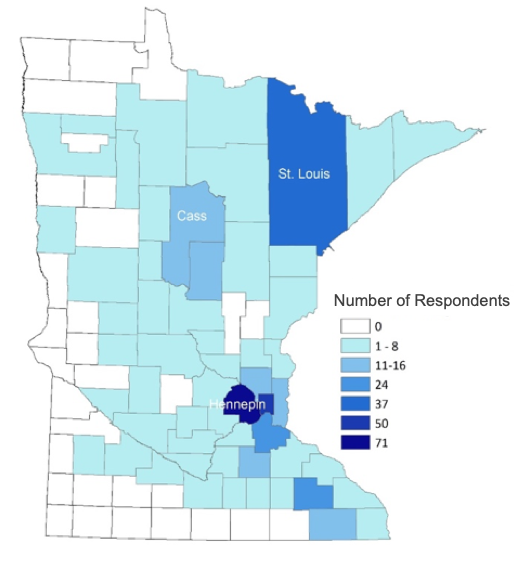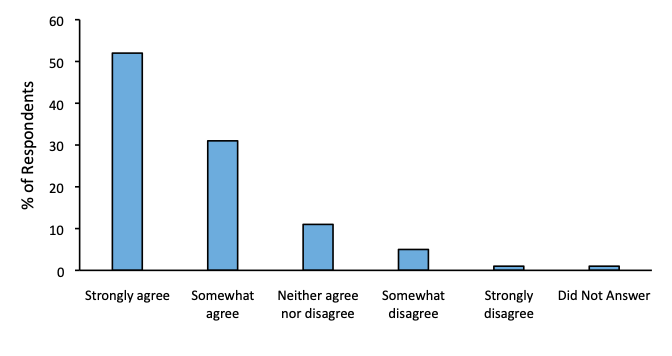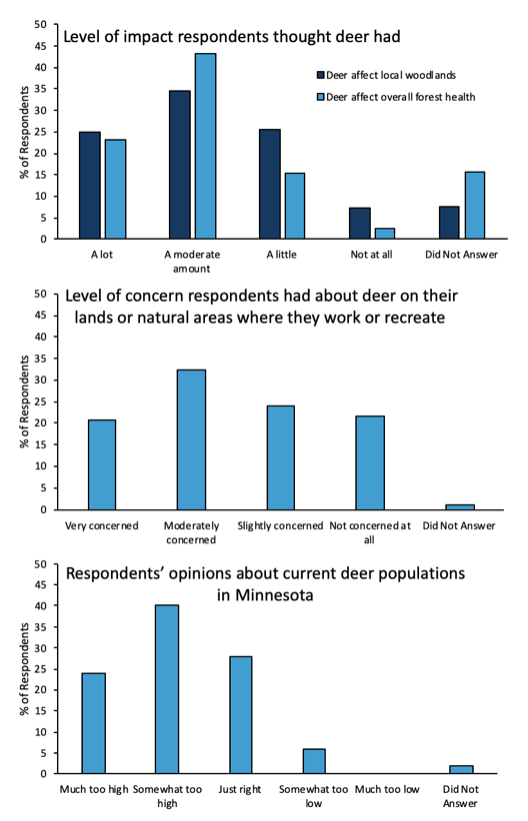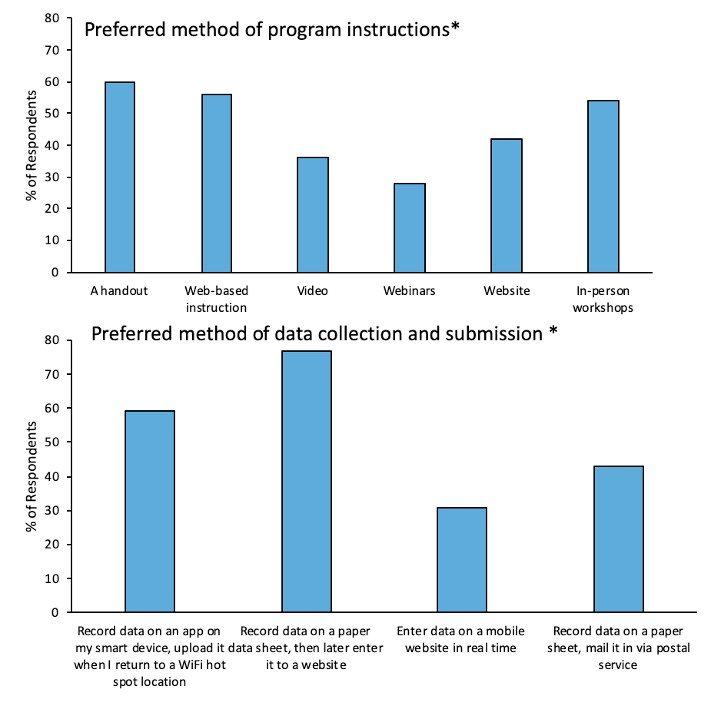 |
April 2020
|
April 2020 // Volume 58 // Number 2 // Research In Brief // v58-2rb11
Gathering Perceptions to Strengthen Program Planning: A Citizen Science Project Highlighting Deer Impacts on Vegetation
Abstract
White-tailed deer can significantly influence the composition and health of forests. University of Minnesota Extension implemented a citizen science project to help monitor the impact of deer populations on forests. Prior to design of the program, we administered a survey to potential volunteers to understand their perceptions of and knowledge about deer and their willingness to participate in our citizen science project. The survey responses helped us make informed decisions when developing our program, including decisions regarding not having a negative deer message, teaching more information about the impact of deer on vegetation, and providing both in-person and web-based resources for volunteers.
Introduction
Understanding how white-tailed deer (Odocoileius virginianus) influence the variety and abundance of plants they browse is important for managing healthy forest ecosystems. Deer are generally considered a keystone species because large populations change the structure and composition of the forests (Côté, Rooney, Tremblay, Dussault, & Waller, 2004; Frerker, Sabo, & Waller, 2014). Deer prefer to browse certain tree species over others (Rooney & Waller, 2003; White, 2012). In areas with high deer populations, preferred tree species become stressed because of deer browse and have difficulty regenerating (Nuttle, Ristau, & Royo, 2014; Rooney & Waller, 2003; Russell et al., 2017). In contrast, species that deer do not prefer (such as invasive plants) thrive and ultimately change the plant species composition of forests (Russell et al., 2017; Waller, Johnson, & Witt, 2017).
To help public land managers and private landowners learn about the impacts of deer on forest vegetation and make informed decisions about managing their woodlands, our team at University of Minnesota Extension, including our author group, sought to implement a citizen science project—Assessing Vegetation Impacts from Deer (AVID)—based largely on protocols developed by Cornell Cooperative Extension (Sullivan, Smallidge, & Curtis, 2016). Prior to launching AVID, we were interested in conducting a needs assessment to gauge interest in and inform the design of this citizen science program.
On the basis of Kaplan and Kaplan's (2008) reasonable person model, we assumed that our prospective citizen scientist volunteers would be inclined toward monitoring and making informed management decisions. Designing effective training for them, then, required understanding their existing mental models about deer impacts on forest vegetation and their information needs and preferences regarding resources and materials provided. Previous studies have addressed the value of conducting various types of audience needs assessments during the planning stages of a program to guide design decisions that make programs more appealing and effective for volunteers. For example, Meyer et al. (2014) described the use of Grabinger and Dunlap's (1995) theoretical framework for active learning environments to structure citizen science programs to drive scientific inquiry in youth. Savanick and Blair (2005) used a focus group–based needs assessment to increase the effectiveness of a new master naturalist program, and the results of the focus group sessions led to enthusiasm and varying viewpoints that had not previously been considered. Takle, Haynes, and Schrock (2017) conducted a survey to better understand the demographics of current master gardeners, allowing them to identify gaps and target underrepresented groups (i.e., younger and more diverse participants) in future recruitment efforts. Although we are not aware of a survey-based needs assessment that focuses on feelings, knowledge, concerns, and preferences, we felt this approach would be useful for our analysis because we were creating a new citizen science program for the region and thus were interested in determining the knowledge and perspectives our prospective volunteers had about deer in Minnesota. Similarly, we desired feedback on the role of deer in forests, a natural resources topic that is often met with differing viewpoints and opinions depending on the audience (e.g., landowners, hunters, forest managers). Herein we describe development of the survey and discuss how results of the study helped us make choices and design a program and training course that aligned with the interests of potential volunteers.
Methods
We used rounds of review to develop and refine a survey comprising 20 questions addressing individual experiences with and perceptions of deer in Minnesota's woodlands. The survey instrument included five categories of questions and was intended to allow us to make informed decisions about our program design. We sought demographic information related to where potential participants lived. We also wanted to understand how potential participants felt about deer populations, what they understood about the impacts of deer on vegetation and how concerned they were about those impacts, and how willing they would be to participate in the proposed citizen science program. Lastly, we wanted to understand what types of instructional resources potential participants thought would be beneficial for learning about the program and what methods they would prefer for collecting and submitting data. We used Qualtrics to deliver the survey. An online survey was the preferred method of data collection because of the ability to reach diverse audiences in a relatively short period of time. The survey was open for 1 month, from August 4 to September 5, 2017, and respondents were not required to answer all questions.
We posted an invitation to complete the survey on established social media channels, including Facebook and Twitter. Additionally, we recruited master naturalists and private woodland owners through email newsletters because they were likely to possess an interest in natural resources and some requisite scientific knowledge. We electronically sent the survey to all active master naturalists in Minnesota. We targeted Minnesota woodland owners by posting the link to the survey on University of Minnesota Extension's MyMinnesotaWoods website and including the link in the website's monthly newsletter.
We used descriptive statistics, including frequencies and percentages of respondents according to categories of interest, to analyze responses for specific survey questions.
Results
Here we describe findings from our survey along with brief synopses highlighting resulting decisions we made regarding design of the AVID citizen science program in Minnesota. The findings and our associated decisions are summarized in a table at the end of this section.
Demographic Information
Four hundred thirty-one people submitted responses. Respondents lived in 56 of Minnesota's 87 counties (Figure 1). Just under half of respondents (47%) were woodland owners (defined as a landowner who owns more than 1 ac of woodland). Most respondents lived in either rural areas (37%) or suburban areas (31%), with somewhat fewer living in urban areas (20%). Respondents commonly selected "other" (10%) when they had two homes. Two hundred ninety-nine respondents (69%) were master naturalists, and 20 respondents (5%) were master woodland owners, having completed the Minnesota Master Woodland Owners program (a much newer program established in 2016 that teaches landowners how to become stewards of their woodland). Further, 26% of respondents were deer hunters.
Figure 1.
Distribution of Respondents Across Minnesota's Counties

Note: n = 431.
Given the diversity of locations in which our participants lived, we decided to adopt a project model that would work for both landowners and participants who did not own land, as well as people across the urban–rural spectrum, to try to include as many volunteers as possible.
Perspectives on Seeing Deer
The survey respondents indicated that they enjoyed seeing deer (Figure 2). The majority of respondents (82%) said they strongly agreed or somewhat agreed that they enjoyed seeing deer. Only 6% indicated that they somewhat or strongly disagreed that they enjoyed seeing deer.
Figure 2.
Respondent Agreement or Disagreement with the Statement That They Enjoy Seeing Deer

Note: Number of respondents to survey was 431.
Given that the majority of respondents enjoyed seeing deer, we decided not to have an anti-deer message. We made the decision to focus instead on how deer fit into the broader ecosystem and how high deer densities can affect forest health.
Understanding of and Concern About Deer Impact on Woodlands
Many respondents (71%) were concerned about deer-caused damage to woodland plants. Results suggested that the majority of respondents had at least some understanding of how deer populations affect forests. Ninety percent of respondents said that deer affect woodlands. In reply to a question asking respondents to explain their perceptions, they listed words or phrases such as "browse," "over browsing," "regeneration," "eating plants," "trees," and "young trees," suggesting at least a basic understanding that deer browsing young trees can limit regeneration and influence forest composition. For example, one respondent stated, "In the spring and summer, they devour the understory of woodlands preventing woodland wildflowers and young trees from growing and replacing the older ones." A few also mentioned increases in invasive plant species as a consequence of overbrowse. One participant wrote, "[They] kill vegetation leaving dead spots for invasive plants to grow. They feed off desirable native understory shrubs like dogwoods and leave buckthorn to proliferate."
Most respondents perceived that deer affect the overall forest and their local woodlands a lot or to a moderate extent and thought that deer populations are too high in Minnesota (Figure 3). Specifically, 23% of respondents said deer affect forest health a lot, and 43% said deer affect forest health a moderate amount. Similarly, 25% indicated that deer affect their local woodlands a lot, and 34% thought that deer affect their local woodlands a moderate amount. Therefore, it is not surprising that 50% of respondents were very or moderately concerned about deer on their land or in local natural areas. Further, 24% thought deer populations in Minnesota were much too high, and 40% thought they were somewhat too high. On the other hand, 28% thought deer populations were just right.
Figure 3.
Respondent Concerns About Effects of Deer on Local Forests and Perceptions of Deer Population Sizes

Note: Number of respondents to survey was 431.
Although many respondents were concerned about deer-caused damage and had at least some understanding of deer impacts on forests, many did not understand the full extent to which deer can affect woodlands, and only about half were concerned about deer. Further, many respondents understood that high deer populations can affect regeneration but did not always understand what lack of regeneration can mean for a woodland. On the basis of what we learned from the survey, we decided to include an educational component about deer and the impacts of deer on vegetation in our citizen science program. We determined that in program volunteer training workshops we would discuss how high deer populations can change the forest structure by stunting regeneration due to their browsing on seedlings. Further, we determined that we would address how deer browsing from high populations can lead to species replacement and the increase of invasive species. We also decided to show example plants and describe the impacts to the landscape that can result from high deer populations.
Willingness to Participate
The majority of respondents were at least moderately willing to volunteer in the AVID program (Figure 4). Fourteen percent indicated that they were extremely willing, 22% very willing, and 34% moderately willing. Willingness to volunteer in the program was similar across three key demographic groups: 69%, 76%, and 71% of deer hunters, master naturalists, and private woodland owners, respectively, were moderately to extremely willing to participate. Similar values for willingness to volunteer were obtained for survey respondents from rural (66%), suburban (74%), and urban (72%) areas. Hennepin County (which includes the city of Minneapolis) had the largest number of respondents who were extremely willing or very willing, followed by St. Louis County and Ramsey County (which includes the city of Saint Paul), suggesting that a wide geographic range would be achieved relatively easily.
Figure 4.
Respondent Willingness to Participate in Citizen Science Project

Note: Number of respondents to survey was 431.
Our findings led us to target regions in which respondents indicated more interest in participating in our citizen science program. As a result, workshops took place in the Minneapolis/Saint Paul metro area. Moreover, given the large number of respondents who were interested but lived in urban areas, we chose to help those volunteers who did not own land connect with public lands to participate in the program.
Preferred Types of Instructional Resources and Methods for Recording and Submitting Data
Respondents who indicated that they were willing to participate in the citizen science project were asked questions regarding their preferences about types of instructional resources and methods for recording and submitting data (Figure 5). Respondents could choose multiple methods.
Regarding resources for learning how to implement the measurement protocols, 60% indicated a preference for a handout with instructions, 56% expressed interest in web-based instruction (including online courses and web materials), and 54% selected in-person workshops as a preferred resource. Respondents were less interested in receiving information on implementing the measurement protocols via videos and webinars (36% and 28%, respectively).
Respondents expressed interest in various methods for recording and submitting data. Most respondents (77%) preferred to record data on a paper data sheet and then later submit to a website. Many respondents (59%) were interested in having an app for a smart device, which could upload data when connected to the Internet. Respondents were somewhat less comfortable recording data on a paper sheet and then mailing the sheet via the postal service (43%) or entering data on a mobile site in real time (31%).
The preferred types of instructional resources and methods for recording and submitting data were similar across various demographics, including deer hunters, master naturalists, and private woodland owners and respondents who lived in rural, suburban, and urban areas.
Figure 5.
Respondents' Preferred Types of Instructional Resources and Methods for Data Collection and Submission

Note: Number of respondents to survey was 431. Respondents were invited to "Check all that apply" for the types of instructional resources and methods for data collection and submission they would prefer.
Due to variation in respondents' preferences regarding resources for learning how to implement the measurement protocols, we chose to provide many different resources for our volunteers. These included half-day workshops where they could learn more about the impact of deer and get trained in the AVID method by learning the methodology and practicing outdoors. We also created a variety of instructional materials for use both at the in-person workshops and online, including instructional handouts, PowerPoint presentations, and videos.
Because of the primary preference for recording and submitting data indicated by respondents, we decided to have volunteers bring paper data sheets into the field with them when they were setting up plots, fill out the sheets by hand, and then later enter the data online via a website.
Summary
The survey results and our associated decisions are summarized in Table 1.
| Category | Key finding(s) | Decision(s) |
|---|---|---|
| Demographic information | Just under half of the respondents owned land.
Respondents lived in 56 of the 87 counties in Minnesota. Two thirds of respondents were master naturalists. |
Given the large number of respondents who were interested but did not own land, we chose to help those volunteers connect with public lands to participate in the program. |
| Perspectives on seeing deer | Respondents enjoyed seeing deer. | We chose not to have an anti-deer message in the workshops. |
| Understanding of and concern about how deer affect woodlands | Respondents understood that deer affect woodlands, but the amount of impact and the full extent of impact were not as well understood.
Just over half of the respondents thought deer populations were too high. |
We chose to include an educational component in the workshops that detailed the impacts deer have on woodlands. |
| Willingness to participate | The majority of respondents were willing to participate in the citizen science project.
Minneapolis/Saint Paul had the highest number of participants willing to participate in the citizen science project. |
We chose to conduct workshops in Minneapolis/Saint Paul to try to increase participation. |
| Preferred types of instructional resources and methods for recording and submitting data | Web-based instruction and in-person workshops were the preferred resources for learning the protocol.
Respondents preferred to be provided with paper data sheets and to submit their data online later. |
We chose to hold in-person workshops that potential volunteers could attend to learn the project protocols.
We chose to provide volunteers with paper data sheets and instructions on how to submit data online. |
Implications for Extension Programming
We designed a citizen science program based on the results of a structured survey we used to understand our volunteers' needs and interests. We found out that respondents understood that deer affect woodlands and that almost half of them owned woodlands, but that they did not understand the full extent of deer impacts in woodlands. Because we found that survey respondents enjoyed seeing deer, we developed positive messaging about deer in volunteer recruitment and program marketing materials. Our survey results indicate that citizen science programs present a clear opportunity for Extension education on issues that are important to landowners, such as deer populations and invasive plants.
As a result, Minnesota began its AVID program in 2018, based largely on the citizen science program outlined by Cornell Cooperative Extension (Sullivan et al., 2016). Our citizen science program involves volunteers identifying and monitoring browse-sensitive tree seedlings known to be palatable by deer for 3 years. Our work has demonstrated that like focus groups and other needs assessment methods, surveys can be a beneficial first step when developing new citizen science programs.
Acknowledgments
We are grateful to all the respondents who completed the survey and helped by contributing to future Extension programming. Our work was supported by University of Minnesota Extension and the U.S. Department of Agriculture National Institute of Food and Agriculture Renewable Resources Extension Act.
References
Côté, S. D., Rooney, T. P., Tremblay, J., Dussault, C., & Waller, D. M. (2004). Ecological impacts of deer overabundance. Annual Review of Ecology, Evolution, and Systematics, 35, 113–147.
Frerker, K., Sabo, A., & Waller, D. (2014). Long-term regional shifts in the plant community composition are largely explained by local deer impact experiments. PLOS ONE, 12(9).
Grabinger, R. S., & Dunlap, J. C. (1995). Rich environments for active learning: A definition. Research in Learning Technology, 3(2), 5–34.
Kaplan, R., & Kaplan, S. (2008). Bringing out the best in people: A psychological perspective. Conservation Biology, 22(4), 826–829.
Meyer, N. J., Scott, S., Strauss, A. L., Nippolt, P. L., Oberhauser, K. S., & Blair, R. B. (2014). Citizen science as a REAL environmental for authentic scientific inquiry. Journal of Extension, 52(4), Article v52-4iw3. Available at: https://joe.org/joe/2014august/iw3.php
Nuttle, T., Ristau, T. E., & Royo, A. A. (2014). Long-term biological legacies of herbivore density in a landscape-scale experiment: Forest understoreys reflect past deer density treatments for at least 20 years. Journal of Ecology, 102, 221–228.
Rooney, T. P., & Waller, D. M. (2003). Direct and indirect effects of white-tailed deer in forest ecosystems. Forest Ecology and Management, 181, 165–176.
Russell, M. B., Woodall, C. W., Potter, K. M., Walters, B. F., Domke, G. M., & Oswalt, C. M. (2017). Interactions between white-tailed deer density and the composition of forest understories in the northern United States. Forest Ecology and Management, 384, 26–33.
Savanick, M. A., & Blair, R. B. (2005). Assessing the need for master naturalist programs. Journal of Extension, 43(3), Article 3FEA7. Available at: https://www.joe.org/joe/2005june/a7.php
Sullivan, K. L., Smallidge, P. J., & Curtis, P. D. (2016). AVID: Assessing vegetation impacts from deer, a rapid assessment method for evaluating deer impacts to forest vegetation. Ithaca, NY: Cornell University Cooperative Extension.
Takle, B., Haynes, C., & Schrock, D. (2017). Using demographic survey results to target master gardener volunteer recruitment. Journal of Extension, 55(3), Article v55-3rb8. Available at: https://www.joe.org/joe/2017june/rb8.php
Waller, D. M., Johnson, S. E., & Witt, J. C. (2017). A new rapid and efficient method to estimate browse impacts from twig age. Forest Ecology and Management, 404, 361–369.
White, M. A. (2012). Long-term effects of deer browsing: Composition, structure and productivity in a northeastern Minnesota old-growth forest. Forest Ecology and Management, 269, 222–228.




